Louisa Ulrika of Prussia
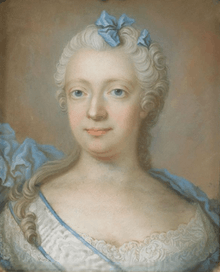
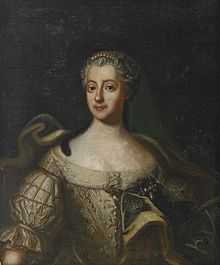
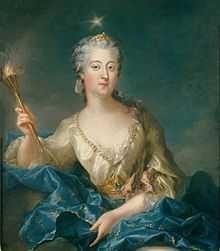
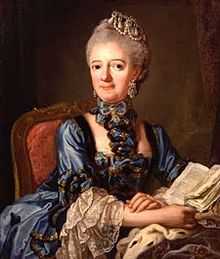
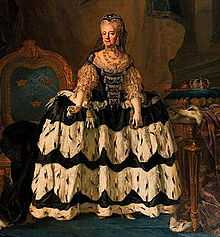
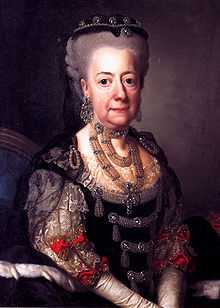
Louisa Ulrika of Prussia (Swedish: Lovisa Ulrika; German: Luise Ulrike) (24 July 1720 – 16 July 1782) was Queen of Sweden between 1751 and 1771 as the spouse of King Adolf Frederick, and queen mother during the reign of King Gustav III.
Background
Louisa Ulrika was born in Berlin as the daughter of Frederick William I of Prussia and his wife Sophia Dorothea of Hanover, and was thus a younger sister of both Wilhelmine of Bayreuth and Frederick the Great. She was given the Swedish name Ulrika because Queen Ulrika Eleonora of Sweden had been her god mother.[1] She exchanged letters with her godmother, and it was thought that she would marry a future son by Ulrika Eleonora, as Ulrika Eleonora herself had once been considered as a consort for Louisa Ulrika's father.[1] However, Ulrika Eleonora remained childless. Other matches were considered, such as Frederick Lewis, Prince of Wales.[1] Upon the accession of her brother to the throne in 1740, she was appointed co-adjutrix of Quedlinburg Abbey with the prospect of becoming a reigning princess-abbess.[1]
Crown Princess
In Drottningholm on 18 August/29 August 1744, Ulrika married Adolf Frederick of Holstein-Gottorp, who had been elected crown prince of Sweden in 1743 and after his succession to the throne in 1751 reigned as King Adolf Frederick of Sweden. She was recommended as a bride by Empress Elizabeth of Russia, just as her spouse was recommended as an heir to the throne by Russia. At first, however, it was her sister Princess Anna Amalia of Prussia who was considered, as her brother warned that Louisa Ulrika was perhaps too ambitious to be a good queen in a monarchy without power, as Sweden was during the Age of Liberty. Her brother king Frederick said that Louisa Ulrika was "arrogant, temperamental and an intriguer", and that they should not let themselves be fooled by her friendliness towards them, while Amalia was mild and "more suitable".[1] It has been suggested, that Fredrick's judgment was given because he believed that Amalia would be easier to control as a Prussian agent than the more dominant Louisa Ulrika.[1] But the Swedish representatives preferred Louisa Ulrika.
Louisa Ulrika was escorted to Sweden by Count Carl Gustaf Tessin. She was received with great enthusiasm in Sweden when she arrived in 1744, as it was hoped that she would finally solve the succession of the Swedish crown, and she gained popularity with her beauty and by the birth of her children; at the birth of her first child, no children had been born in the Swedish royal house in over fifty years.
At her arrival, she was given Drottningholm Palace, where she resided with her young court. She was described as beautiful, cultivated - entirely according to the French tradition - and interested in science and culture. Count Carl Gustaf Tessin called her: "A mind of a god in the Image of an angel",[1] but she was also seen as extremely proud and arrogant, which made her less and less liked outside of the aristocracy over the years.
The court of the crown prince couple, called "The young court", amused themselwes with picnics, masquerades and French amateur theatre.[1] Her first favorite among her ladies-in-waiting was Henrika Juliana von Liewen, who was an eager follower of the Hat's Party, and another well known lady-in-waiting were Cathérine Charlotte De la Gardie. The "young court" was also strongly affected by count Tessin. Count Carl Tessin had escorted Louisa Ulrika to Sweden, and he and his wife maintained a strong influence over Louisa Ulrika during her first years in Sweden.[1] Prince Adolf Frederick never cared much for Tessin, but in 1745, Count Tessin was appointed royal court marshal Countess Ulla Tessin as first lady-in-waiting. Soon, Tessin also acquired the position of governor to Louisa Ulrika's first son. Tessin was behind many happy surprises and arrangements for amusements in the young court, and it was said that he was only too eager to please Louisa Ulrika in any way possible[1]
During her time as a crown princess, there were rumors that Louisa Ulrika had an affair with count Tessin.[1] This was with all certainty not true: her son Gustav III later replied to these rumors, that although Count Tessin had been in love with her, his feelings were one-sided and not answered by his mother, as a love affair with a noble contradicted the "natural contempt" which Louisa Ulrika herself felt for every subject, noble or not[2]
Already as a crown princess, she was politically active. In the Christmas of 1744, she visited Tessin and gave him a lantern in the guise of the goddess Diana with the inscription: "Made only to shed light on the political system of the day".[1] Her political ideal was absolute monarchy, and she disliked the Swedish constitution from the moment it was explained for her. She also disliked the legal system; when she at one point thought herself exposed to a plot, she wrote: "The laws are so strange, and one does not dare to arrest someone on mere suspicion without proof, which benefit the individual more than the kingdom."[1]
At her own court, she was surrounded by nobles loyal to the Hats (party), and initially she allied herself with them in her ambition to restore the power of the royal throne.[1] After the first years, however, she soon begun to gather followers from all parties to establish the Hovpartiet, English:"Royal court party")[1] After the birth of her eldest son in 1746, she and the crown prince gathered followers also from the Caps (party).[1] She learned Swedish and visited several of the Cap's most prominent members. At the visit of the Cap's parliamentary Kalsenius, she wrote that he was: "The biggest villain in the world, but I will not leave until I have bribed him. That is the only means by which one can reach the goal one has in mind"[1] She disliked the alliance between Sweden and Russia, and in 1747, she affected the votes in the parliament by bribing.[1] Whether it was because of this or not, the parliament voted for an alliance between Sweden, Prussia and France that year.[1]
Queen
In 1751, Louisa Ulrika became queen. She revitalized the royal court, which had been neglected during the reign of King Frederick, and founded a theater at Drottningholm Palace. Her interest for theater was, however, entirely French-influenced, and she interrupted the development of a native Swedish national theatre at Bollhuset by replacing it with a French Theatre, the Du Londel Troupe, which was only a benefit for those who could speak French,[3] the aristocratic language of various European courts at that time (Berlin, St. Petersburg, Dresden, Madrid, etc.).
In 1753, she founded the Witterhetsakademin, an academy which counted Carl von Linné among its members. She was a great patron of science and art, a protector of the work of scientists such as Carl von Linné and artists such as the painter Ulrika Pasch and the poet Hedvig Charlotta Nordenflycht. Nordenflycht was given a pension of $600 until she was given the same pension from the state in 1752. Her "adoption" of Gustav Badin in 1757 was intended as a form of scientific experiment.
The year 1754 was the year of the alienation of Count Tessin. In 1751, Tessin seemed to have fallen from grace and he wrote that she no longer discussed politics with him and "claimed that she took no part in politics".[1] The year before, he had convinced her to agree to the engagement between her eldest son and a Danish princess, when she herself had preferred another bride.[1] At this point, Count Tessin was reported to no longer be in control of his infatuation of her, and it was noted in court that the king had "taken against" Tessin.[1] Crown Prince Gustav wrote in 1769, that Tessin had made Louisa Ulrika "suggestions far from the reverence one is expected towards a sovereign"[2] Louisa Ulrika informed the king, who had surprised Tessin on his knees before the queen, after which the count and the countess Tessin lost their positions.[2] The queen only remarked that she missed countess Tessin. Her favourite was her lady-in-waiting Ulrika Eleonora von Düben, who replaced Henrika von Liewen in 1748 and was appointed first lady-in-waiting in 1756 after Ulrika Strömfelt. Düben was the niece of Emerentia von Düben, who had been the favorite lady-in-waiting of queen Ulrika Eleonora, and her critics in the court described her as a typical representative of an ingratiating court-noble.
As soon as she became queen in 1751, she made preparations to overthrow the Swedish parliament, the Riksdag. The vow to respect the constitution which her husband made upon his accession to the throne was a great sorrow for her.[1] Her attempt of a royalistic revolution was prevented in 1756. The same year, Sweden entered the Seven Years' War on the side against Prussia, a step she opposed.[1] In 1763, the Swedish government asked her to issue negotiations with her brother, the King of Prussia, in order to prevent the Swedish province of Pomerania in Germany from being annexed by Prussia.[1] She agreed after great persuasion and handled the negotiations successfully, which has been described as a form of triumph for her over the Riksdag. As a sign of gratitude for this act, the government paid her debts, which made it possible for her to use her money to affect the voting in the Riksdag through bribes.[1] Her plan was now to change the constitution through this method.[1]
After the 1766 election, her attempts had failed, and her political power position was over[1] The last years of her husband's reign, the anti-parliamentarian opposition looked to her son Crown Prince Gustav instead of her. Her relationship with her son became tense after this. Louisa Ulrika had the wished for Gustav to marry her niece Philippine of Brandenburg-Schwedt, and was forced to agree to the engagement to Sophia Magdalena of Denmark against her will. She was therefore much displeased when Gustav himself agreed to go through with the Danish marriage in 1766.[1] During the 1768 conflict between the monarchy and the parliament, when the king threatened to abdicate if he was not granted more power and the country was on the verge of a coup, the royalists turned to her son for leadership instead of her[1]
Her arrogance, her political views and her conflicts with the Riksdag made her less and less liked during her husband's reign. Carl Gustaf Tessin once said about her: "Our queen would have been the most staunch republican if she had been born a subject", but she was born within a class which fought to keep their privileges and power[1]
The Failed Royal Revolution of 1756
Queen Louisa Ulrika strongly dominated her husband and the court, and she would likely had been the real ruler during her husband's reign if the Swedish monarchy had not been stripped of its power in 1718 and 1720; at this point, the king was a mere decoration and Sweden was a monarchy only in name. This greatly displeased the queen, herself born in an absolute monarchy. She could not understand nor condone the Swedish parliament, the Riksdag. For her, it was not acceptable for a royal person to have to receive peasants in the royal salons, as she was forced to do with the peasant's representatives from the Riksdag. She was further enraged when the Riksdag forced the king to give up his claims on the throne of Holstein-Gottorp, and arranged the marriage between her son Gustav to Sofia Magdalena of Denmark, when she herself had preferred a German princess.[1] She was enraged when the parliamentaristic C.F.Scheffer was appointed her son's educator. In 1755, the Riksdag decided that, if the king refused to sign the laws issued by the government, a stamp would be used instead.
To display her contempt, she humiliated the representatives of the Riksdag by using the etiquette of the royal court; she stopped their carriages at the Palace gates, forced them to wait for hours while she let those who arrived before them be received, and let them sit on small little low stools before her to make them lose their dignity.
In the three months following her coronation, Louisa Ulrika removed the diamonds from the crown and replaced them with glass. She gathered followers among the aristocracy to plan a coup d'état to overthrow the government, dissolve the Riksdag and reinstate absolute monarchy in Sweden. Her followers were called Hovpartiet (English: "The royal court party"), and they were noblemen in opposition to the Riksdag for personal reasons, wishing for rewards from the queen after a successful coup. In the court theatres, the French theatre troupe and the Italian opera company performed plays hinting that the king should taken control over his kingdom[3]
To finance the coup, the Queen pawned the jewelry she had been given as a wedding gift by the state, as well as some of the crown jewels belonging to the state, among them 44 diamonds she had placed in the Queen's Crown, which she pawned in Berlin to borrow money.[1] The lady-in-waiting of the Queen, Ulrika Strömfelt, informed the government that parts of the crown jewels were missing. For this act, she was later to receive the honorary title Ständernas dotter (English:"Daughter of the Parliament") and a pension of $2000. The government demanded to inspect the crown jewels, as it was the property of the state. The Queen refused, as she did not recognise any right of the government to inspect anything. In parallel, the king was taken ill, and the government retreated to allow him to recover, giving the queen time to provide the diamonds back for the inspection. At the same time, weapons and bullets were being made. The plan was to hire criminals to cause chaos on the streets: the royalist officers would then block the streets, the royalists would be armed and the King would enter the square to "resume control", after which the public would "celebrate him as the saviour from the Riksdag"[1]
The plans were often discussed at the pub of the royalist Ernst Angel. Angel was the illegitimate son of Maximilian of Hesse-Kassel, King Frederick's brother, which he often pointed out. The 21 June 1756, the police heard Angel talk about the plans of a royal revolution while he was drunk. He was arrested and interrogated, and the next day, the arrests of the noblemen begun. When the royal couple entered Stockholm after a stay at from Drottninghom Palace that night the streets where filled with the military. The whole conspiracy against the Riksdag was discovered. The Riksdag voted for a death sentence for four of the involved noblemen, who were decapitated on Riddarholmstorget in Stockholm in front of thousands of spectators, outside the royal palace, and three days later, Ernst Angel and three more were decapitated. Several others were sentenced to prison, whipping, exile and the pillory, and by being banned from seats in the parliament.
The Queen, who was the instigator behind all this, received a strong note from the Riksdag communicated by the archbishop, who forced her to write a letter of confession and regret. The archbishop reported, that he thought he had seen "tears of rage and sorrow" in her eyes.[1] She herself wrote that she had tried to display: "all the coldness, all the contempt possible to make in a demonstration",[1] and she regretted nothing but that her revolution had failed. The king had a statement read to him saying that he would be deposed if the queen ever attempted something similar again.
Queen Dowager
In 1771, the king died and she became a queen dowager. Louisa Ulrika was at the death of the king immensely unpopular in Sweden: when the news of the king's death reached her son, the new king Gustav III of Sweden, who was then in Paris, he wrote that the queen dowager be protected, as "I know how little loved my mother is".
In 1772, her son the new king succeeded where she had failed in 1756 by overthrowing the democracy and reinstating absolute monarchy, His revolution was a great satisfaction to her.[1] Louisa Ulrika wrote to Gustav III to gratulate him to the coup upon which she said: "Yes, you are my son, and you deserve to be"[1] At the time of the coup, she was in Berlin with her daughter. She was present in Swedish Pomerania when the Province gave their allegiance to the new constitution. When her brother, the king of Prussia, told her that the neighboring countries would now attack Sweden, she wrote to him that she would defend the province of Pomerania against him with her own blood[1]
Louisa Ulrika could, however, never settle with the position of queen dowager. She had expected to be the real ruler behind the throne, and when her son made it clear that he would rule independently from her, their relationship worsened.[1] In 1772, he prevented her plans to marry off her second son Charles to Philippine of Brandenburg-Schwedt, and in 1774, Charles was married to Hedwig Elizabeth Charlotte of Holstein-Gottorp instead.[1] Gustav III paid her debts with the condition that she established her own separate court at Fredrikshof Palace.[1] In 1777, she was forced to sell Drottningholm Palace to her son Gustav. She did not get along with either of her daughters-in-law, calling Sophia Magdalena of Denmark "cold and shy" and Hedwig Elizabeth Charlotte of Holstein-Gottorp "flirtatious."
In 1777-78, the conflict with her ruling son erupted and she was a central figure in the great succession scandal regarding the legitimacy of the crown prince. In 1777, her two younger sons, Charles and Frederick Adolf, visited her. They claimed all women at court had lovers, and that with the exception of their mother, they could not think of even one who did not.[1] Louisa Ulrika suggested that they make another exception: surely the queen must also be an exception? In reply, her sons laughed and asked her if she had not heard of the rumors that Sophia Magdalena had an affair with Fredrik Munck. She became very upset and ordered prince Charles to investigate if this where true, as his inheritance to the throne would be endangered by "the common offspred of a common nobleman". Charles talked to Munck, Munck talked to king Gustav, Gustav talked to Charles who claimed the whole thing was the fault of the queen dowager, which resulted in a great conflict between mother and son. When the son of the king was born in 1778, rumours pointed out him as the son of Munck. Louisa Ulrika accused the king of having another man father his child. A great scandal erupted, during which the king even threatened to exile her to Pomerania. In the following conflict, her youngest children, Sofia Albertina and Frederick, who had always been her favourites, took her side against the king. Louisa Ulrika was forced to make a formal statement, during which she withdrew her accusation. The statement was signed by the entire adult royal family except the royal couple; two princes, the princess, the Duchess, and six members of parliament. The relationship with Gustav was not repaired until her death bed. She died in Svartsjö.
Children
She had the following children:
- (Stillborn) (1745)
- Gustav III of Sweden (1746–1792)
- Charles XIII of Sweden (1748–1818)
- Frederick Adolf (1750–1803)
- Sophia Albertine (1753–1829)
See also
- L’Ordre de l’Harmonie
Ancestry
| Ancestors of Louisa Ulrika of Prussia | ||||||||||||||||||||||||||||||||||||||||||||||||||||||||||||||||||||||||||||||||||||||||||||||||||||||||||||||||||||||||||||||||||||||||||||||||||||||||||||||||||||||||||||||||||||||||||||||||||||||||||||||||||||||||||||||||||||||||||||||||||||||||||||||||||||||||||||||||||||||||||||||||||||||||||||||||||||||||||||||||||||||||||||||||||||||||||||||||||||||||||||||||||||||||||||||||||||||||||||||||||||||||||||||||||||||||||||||||||||||||||||||||||||||||||||||||||||||||||||||||||||||||||||||||||||||||||||||||||
|---|---|---|---|---|---|---|---|---|---|---|---|---|---|---|---|---|---|---|---|---|---|---|---|---|---|---|---|---|---|---|---|---|---|---|---|---|---|---|---|---|---|---|---|---|---|---|---|---|---|---|---|---|---|---|---|---|---|---|---|---|---|---|---|---|---|---|---|---|---|---|---|---|---|---|---|---|---|---|---|---|---|---|---|---|---|---|---|---|---|---|---|---|---|---|---|---|---|---|---|---|---|---|---|---|---|---|---|---|---|---|---|---|---|---|---|---|---|---|---|---|---|---|---|---|---|---|---|---|---|---|---|---|---|---|---|---|---|---|---|---|---|---|---|---|---|---|---|---|---|---|---|---|---|---|---|---|---|---|---|---|---|---|---|---|---|---|---|---|---|---|---|---|---|---|---|---|---|---|---|---|---|---|---|---|---|---|---|---|---|---|---|---|---|---|---|---|---|---|---|---|---|---|---|---|---|---|---|---|---|---|---|---|---|---|---|---|---|---|---|---|---|---|---|---|---|---|---|---|---|---|---|---|---|---|---|---|---|---|---|---|---|---|---|---|---|---|---|---|---|---|---|---|---|---|---|---|---|---|---|---|---|---|---|---|---|---|---|---|---|---|---|---|---|---|---|---|---|---|---|---|---|---|---|---|---|---|---|---|---|---|---|---|---|---|---|---|---|---|---|---|---|---|---|---|---|---|---|---|---|---|---|---|---|---|---|---|---|---|---|---|---|---|---|---|---|---|---|---|---|---|---|---|---|---|---|---|---|---|---|---|---|---|---|---|---|---|---|---|---|---|---|---|---|---|---|---|---|---|---|---|---|---|---|---|---|---|---|---|---|---|---|---|---|---|---|---|---|---|---|---|---|---|---|---|---|---|---|---|---|---|---|---|---|---|---|---|---|---|---|---|---|---|---|---|---|---|---|---|---|---|---|---|---|---|---|---|---|---|---|---|---|---|---|---|---|---|---|---|---|---|---|---|---|---|---|---|---|---|---|---|---|---|---|---|---|---|---|---|---|---|---|---|---|---|---|---|---|---|---|---|---|---|---|---|---|---|---|---|---|---|---|---|---|---|---|---|---|---|---|---|---|---|---|---|---|---|---|---|---|---|---|---|---|---|---|---|---|---|---|---|---|---|---|---|---|---|---|---|---|---|---|---|---|---|
| ||||||||||||||||||||||||||||||||||||||||||||||||||||||||||||||||||||||||||||||||||||||||||||||||||||||||||||||||||||||||||||||||||||||||||||||||||||||||||||||||||||||||||||||||||||||||||||||||||||||||||||||||||||||||||||||||||||||||||||||||||||||||||||||||||||||||||||||||||||||||||||||||||||||||||||||||||||||||||||||||||||||||||||||||||||||||||||||||||||||||||||||||||||||||||||||||||||||||||||||||||||||||||||||||||||||||||||||||||||||||||||||||||||||||||||||||||||||||||||||||||||||||||||||||||||||||||||||||||
Notes
- ↑ 1.0 1.1 1.2 1.3 1.4 1.5 1.6 1.7 1.8 1.9 1.10 1.11 1.12 1.13 1.14 1.15 1.16 1.17 1.18 1.19 1.20 1.21 1.22 1.23 1.24 1.25 1.26 1.27 1.28 1.29 1.30 1.31 1.32 1.33 1.34 1.35 1.36 1.37 1.38 1.39 1.40 1.41 1.42 Olof Jägerskiöld (Swedish): Lovisa Ulrika, drottning av Sverige (English: Louisa Ulrika, queen of Sweden) (1945)
- ↑ 2.0 2.1 2.2 Valborg Lindgårde & Elisabeth Mansén (Swedish): Ljuva möten och ömma samtal (English: Sweet encounters and tender conversations) (1999)
- ↑ 3.0 3.1 Anna Ivarsdotter Johnsson och Leif Jonsson (Swedish): Musiken i Sverige. Frihetstiden och Gustaviansk tid 1720-1810 (English: Music in Sweden. The Age of liberty and the Gustavian age.)
References
- Herman Lindqvist (Swedish): Historien om alla Sveriges drottningar (English: The history of the Queens of Sweden) Norstedts Förlag. ISBN 91-1-301524-9.
- Anna Ivarsdotter Johnsson och Leif Jonsson (Swedish): Musiken i Sverige. Frihetstiden och Gustaviansk tid 1720-1810 (English: Music in Sweden. The Age of liberty and the Gustavian age.)
- Herman Lindqvist (Swedish): Historien om Sverige. Från Istid till Framtid (English: History of Sweden. From ice age to our age)
- Stig Hadenius (Swedish): Vad varje svensk bör veta. Sveriges historia(English: What every Swede should know. The history of Sweden.)
- Herman Lindqvist (Swedish): Historien om Sverige. Gustavs dagar (English: The history of Sweden. The days of Gustav)
- Olof Jägerskiöld (Swedish): Lovisa Ulrika, drottning av Sverige (English: Louisa Ulrika, queen of Sweden) (1945)
- Valborg Lindgårde & Elisabeth Mansén (Swedish): Ljuva möten och ömma samtal (English: Sweet encounters and tender conversations) (1999)
| Louisa Ulrika of Prussia Born: 24 July 1720 Died: 16 July 1782 | ||
| Swedish royalty | ||
|---|---|---|
| Preceded by Ulrika Eleonora of Sweden |
Queen consort of Sweden 1751–1771 |
Succeeded by Sophia Magdalena of Denmark |
| ||||||||||||||||||||||||||||||||||||||||||||||||||||||
| ||||||||||
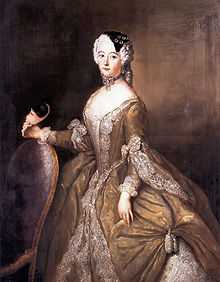
.png)